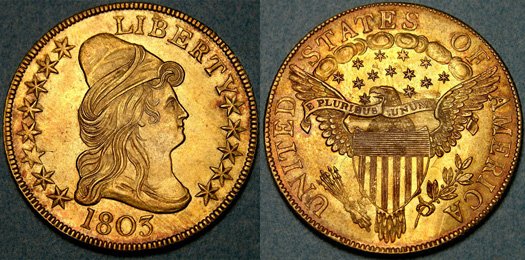Capped Bust Eagle
Source: My Coin Guides: The Capped Bust Eagle was struck from 1795 until 1804, across two different subtypes and several varieties. At the time of issue, the eagle valued at $10, represented the the largest denomination within America’s coinage system. High quality examples are elusive, particularly for the first subtype. Many surviving specimens will display mounting remnants, repairs, or cleaning, making original and unimpaired coins highly desirable. Completion of a complete date set is an obtainable goal given the proper budget, however, for most collectors the goal might be to acquire a single coin to represent the type.

The Mint Act of 1792 authorized the production of three different gold denominations. The half eagle with a value of five dollars was the first to be produced, followed by the eagle with a value of ten dollars. The quarter eagle, valued at $2.50, would not be produced until 1796. The largest ten dollar denomination was intended for use in international trade, although pieces from other countries generally served this purpose. Use within domestic commerce was limited due to the high value of the coin. The few people of the late 18th century who had the opportunity to obtain a gold piece of such a high value would generally save it instead of spending it. Accordingly, mintages for the Capped Bust Eagles were relatively small, especially compared to the gold half eagles, which would become the coin of choice for smaller international transactions.
The obverse of the Capped Bust Eagle features the bust of Liberty, facing right. The truncation is just below the upper part of the neck, which draped by a small part of clothing. Liberty wears a Phrygian cap with a lock of hair wrapping upwards, which gives the appearance of a turban. The word “LIBERTY” appears above, the date below, and stars to either side of the coin, coming in various counts and arrangements. The coins of 1795 and some of 1796 contain fifteen obverse stars. After Tennessee was admitted into the Union in mid-1796, a sixteenth star was added. In 1798 the number of stars was reduced to thirteen, which would remain the case until the end of the series. Some aspects of the obverse design lend to alternate names for the series, including Turban Head Eagle or Draped Bust Eagle.
The initial reverse design for the series features an eagle of rather slim appearance, perched on a palm branch with wings spread. The branch usually has thirteen leaves, although one reverse die is known with only nine leaves. The eagle holds an olive branch wreath in its beak. The branch on which it sits usually has thirteen leaves, although one reverse die is known with just nine leaves. The words “UNITED STATES OF AMERICA” surround the image with the bottom area left blank. No denomination is included on either side of the coin, as these pieces were valued at their weight. This reverse was known as the “small eagle” type and used from 1795 to 1797.
The second reverse, known as the “heraldic eagle” type, is based on the Great Seal of the United States. An eagle appears in a rather unnatural position with a shield against its breast. Thirteen small stars are between the eagle’s head and a cluster of clouds above. In the eagles claws are an olive branch and a bundle of arrows. Once again, “UNITED STATES OF AMERICA” is around, and no denomination is mentioned. This reverse design was introduced during 1797 and used until the end of the series in 1804. The obverse and both reverse designs were by Robert Scot.
Production of the Capped Bust Eagle continued somewhat regularly until 1804 when Thomas Jefferson halted the production of gold eagles. At this time the Napoleonic Wars had driven the world price of gold higher and large quantities of U.S. gold coins were being melted. The denomination would not resume until 1838, after Congress adjusted the bimetallic ratio of gold and silver within U.S. coinage.
